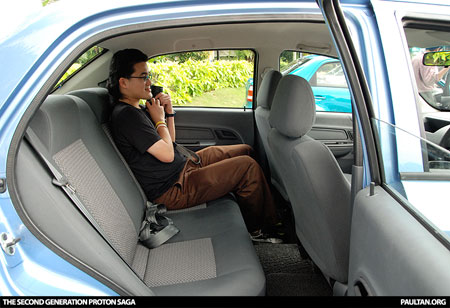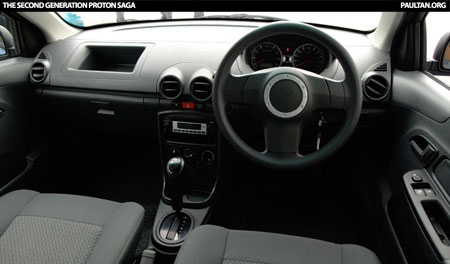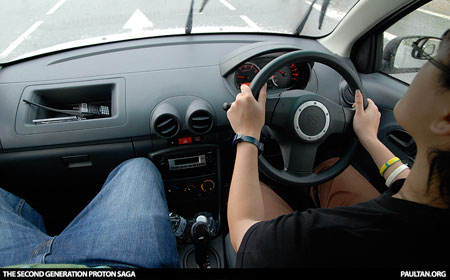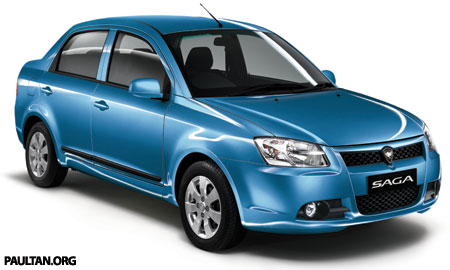
new Proton
This is probably the most anticipated car in the history that I have had this blog running, the car that will mark the retirement of the old Proton Saga and mark the beginning of a new saga in the history of Proton. It is what both we and Proton call “the People’s Car”.
It is the car that signifies Proton is going back to the basics and fulfilling its responsibility as the national car manufacturer to actually produce national cars that the majority of the people actually need – a cheap, economical run-about car with a sedan bodystyle.
That car is the new second generation 2008 Proton Saga, known to us for the past few months as the Proton BLM.
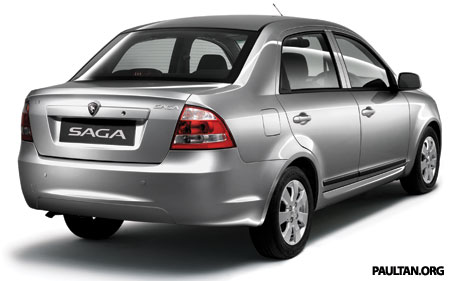
As most of you should know by now, the new Proton Saga was engineered from the Proton Savvy’s platform, by a team that was led by Proton engineers together with external consultants, including LG CNS. It was developed in a record period of 17 months from the design freeze stage to the SOP stage. It was designed to be a simple, affordable and practical entry level sedan. You could call it the people’s car if you wish, something the original Volkswagen Beetle was a long time ago.
Proton decided to do away with any attempts at making this car “different”, from the beginning it was decided that its design was to be smart and simple. The front features a hexagonal mesh front grille, swept-back headlamps, and prominent lower air intakes on the bumper, while the rear of the car features wraparound crystal cluster lights and a concave boot lid. From the side you can see prominent wheel arches, which give the car a sportier look.
Thankfully, there are no design quirkiness to be seen, and the car lacks the typical hatch turned sedan awkward look that the Suzuki Swift Sedan and the Nissan Latio have.
For a small sedan like the Saga, what many will be looking at is how much interior space it has. So let’s have a look at how the new Proton fares in that area.
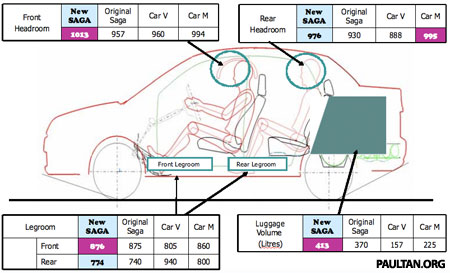
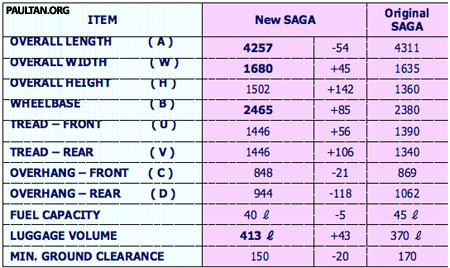
The new Proton Saga is bigger than its predecessor in pretty much every way possible. You’ll probably be able to guess what cars Competitor M and Competitor V are. Numbers are good, but they remain just figures on a piece of paper until you actually try getting into the car.
Here we have regular PAULTAN.ORG contributor Shannon Teoh in the rear seat of the car. You can see clearly the legroom and headroom available to the rear passenger – surprisingly good! The only concern would be the width of the car, it is narrower but acceptable given that this is a small B-segment sedan.
Either 2 adults or 3 children will sit comfortably in the rear bench, and there are seatbelts for 3 people, so if the government enforces the rear seatbelt rule anytime soon, the Proton Saga will be ready for it.
Interior conveniences include two cupholders in the front, one cupholder in the rear, an open storage compartment where the passenger airbag would be expected to be, a glove compartment, two rear bottle holders, door pockets on each door, seatback pockets, a 1-DIN storage area below the 1-DIN CD player, and finally a little compartment just below the steering wheel column.
 The Proton Saga has a standard car power outlet socket positioned at a 90 degree horizontal angle just below the air conditioning controls. This might cause a problem with some of the longer devices that you might want to insert into the socket, like mobile phone chargers and etc, as it might get into the way of the gear lever. If you have drinks in the front cupholders, these might obstruct the power outlet as well.
The Proton Saga has a standard car power outlet socket positioned at a 90 degree horizontal angle just below the air conditioning controls. This might cause a problem with some of the longer devices that you might want to insert into the socket, like mobile phone chargers and etc, as it might get into the way of the gear lever. If you have drinks in the front cupholders, these might obstruct the power outlet as well.
The air conditioning controls themselves (click image on the left to enlarge) are very simple and intuitively designed. This is an improvement over the Proton Persona’s air conditioning controls where the temperature dial was somewhat confusing. Previously readers who have seen the dials have said they look like they were recycled from the old Mitsubishi-generation Protons, but these are new stepped dials. I’m not sure what the proper term is, but it means that when you twist the dial, you feel feedback from the dials, they “click” from setting to setting, while the old dials in the Saga/Iswara/Satria/Wira were stepless, you just twisted them around and they don’t give any feedback as to whether you’ve actually achieved anything or not.
The only stepless dial is the one where you control whether the air conditioning system recirculates the air or takes in fresh air from outside. This has been made into a dial instead of a button of sorts because the control actually requires the action of you twisting the knob to close the external air intake vent – basically its a manual system.
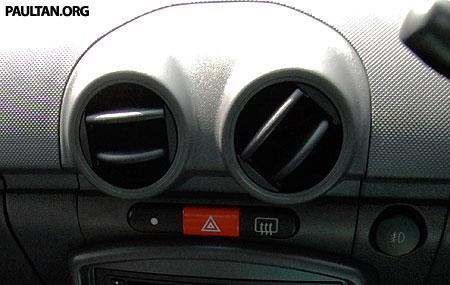
The air conditioning vents integrate angle and open/close functions in a single action, much like the ones on the Satria Neo. The dashboard plastics do not fall into the soft touch category, but Proton has added texture so that they do not look or feel cheap, and I appreciate that thought. I do not really have a problem with the plastics. The stepped dials and switches do not have a cheap feel to them, and all of them provide feedback as to whether you’ve actually pressed them, which is an improvement over the Persona’s feedbackless dashboard buttons.
The switches, knobs and dials are all placed in intuitive positions. My only issue with the interior is not something major. It’s just that Proton does not seem to have a standard Human Interface Design template for their interiors. A little button with a dot on it activates the central locking system in the Proton Persona, but the same button in the Saga is used to deactivate the alarm system! The same design, but different meanings in different cars. This will have to change in the next generation of cars.

Audio is provided by a single CD Clarion head unit, and either 2 speakers for the N-Line and B-Line, or 4 speakers for the M-Line. The silver head unit lights up with red backlighting, matching the rest of the car.
I wish Proton has specified to Clarion that the volume knob be on the right side of the head unit instead of on the left, as this is a right hand drive market. If you notice, the Clarion 2-DIN head unit used in the Mitsubishi-generation Protons and the Waja had the volume knob on the right. Nevertheless, the audio output through the speakers was rather decent, but being a 1-DIN unit there will be many who will swap everything out for their own custom ICE setup.
I am not completely sure, but I reckon that if you take out the 1-DIN storage compartment module from below the 1-DIN head unit, you’ll probably be able to install a 2-DIN unit.
The picture above shows how the front passenger area of the Proton Saga would typically be looking like. The passenger’s legs are in the photo to let you judge the interior width of the car better. The driving position for both the manual and automatic versions were decent without issues.
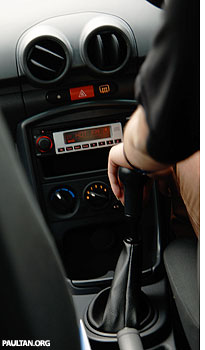 For the manual version, the clutch pedal was adequately spaced away from the brake and accelerator pedals, unlike some previous Protons. The automatic shifter uses the P-R-N-D-3-2-L shift pattern – no shiftronic-like features here.
For the manual version, the clutch pedal was adequately spaced away from the brake and accelerator pedals, unlike some previous Protons. The automatic shifter uses the P-R-N-D-3-2-L shift pattern – no shiftronic-like features here.
The manual shifter is really something I’ve never seen before! The shift lever is so tall and the shift throw is rather long. The high position of the shift knob shortens the distance your hand has to travel from steering wheel to shifter, so many it was intentional. The lever’s free play both in neutral and in gear was also quite noticable, and it all reminded me of a pickup truck’s manual shift lever, although the lever did not vibrate like how a pick up truck’s normally would. Shifts felt rubbery and disconnected, not very fun but nevertheless it gets the job done.
Clutch engagement and disengagement for the manual transmission happens quite far into the clutch release. It should be quite safe if you accidentally shift without pressing the clutch pedal to the very deepest, as somewhere past mid point the clutch would have already fully disengaged.
On to the new Proton Saga’s best kept secret. The new 1.3 liter Campro IAFM engine. Let’s get to the low down on whats changed since the last iteration of the Campro 1.3 found in the Proton Satria Neo. Firstly, the manual gearbox that comes with this engine is now sourced from Aichi Kikai instead of Mitsubishi, which Proton engineers say allows them greater flexibility in specifying gear ratios, something that Mitsubishi did not provide.
Next, the engine has an Integrated Air Fuel Module which integrates a variable length intake manifold system. I will not go into lengths explaining what a variable length intake manifold system is since I have already done that before (click here to read).
The electrical system has also been updated. Ignition now uses coil-on-plug ignition, which eliminates spark plug cables from the ignition system. This eliminates some power losses caused by spark plug cables. The starter is now of a smaller physical size, but has a bigger capacity. If you listen to how this Campro IAFM 1.3 engine starts compared to the Campro 1.3 in the Satria Neo, you can hear the difference. Think of how the Perdana V6 sounds like when it starts.
The Campro IAFM engine keeps the Campro 1.3’s 94 horsepower at 6,000rpm and 120Nm of torque at 4,000rpm figures, with changes only to the way the power and torque is delivered instead of any change in the peak power and torque. Proton’s dyno tests of the new Campro IAFM engine reveals power ratings of up to 98 horsepower is achievable, but Proton prefers to publish the power figures in brochures at 94 horses for some reason, perhaps for consistency sake as not all engines may be able to achieve the 98 horses figure.
 Proton 08
Proton 08 Proton 07
Proton 07 Proton 06
Proton 06 Proton 05
Proton 05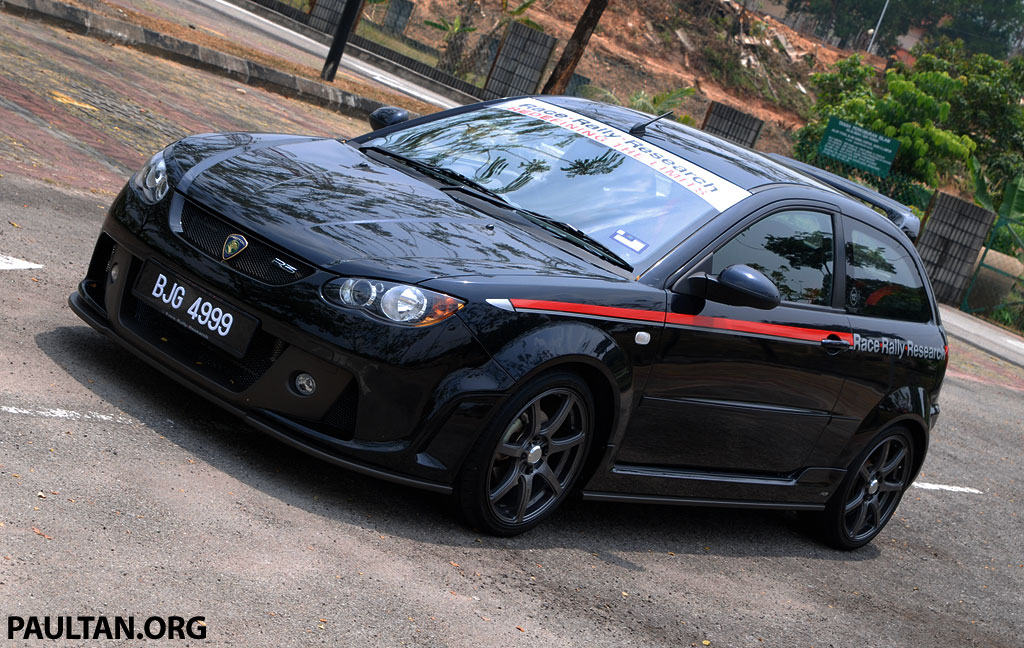 Proton 04
Proton 04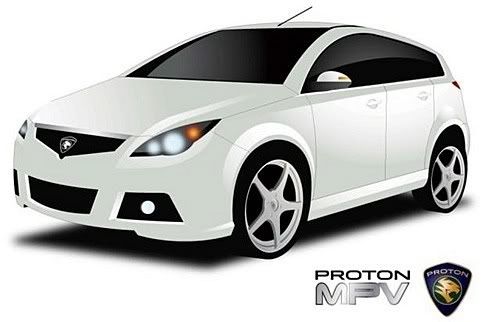 Proton 03
Proton 03 Proton 02
Proton 02 Proton 01
Proton 01 Proton
Proton
